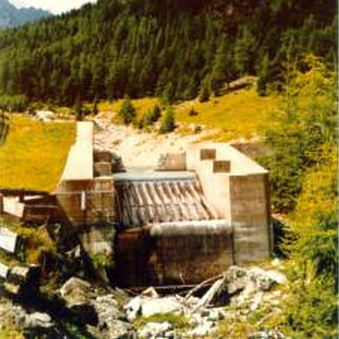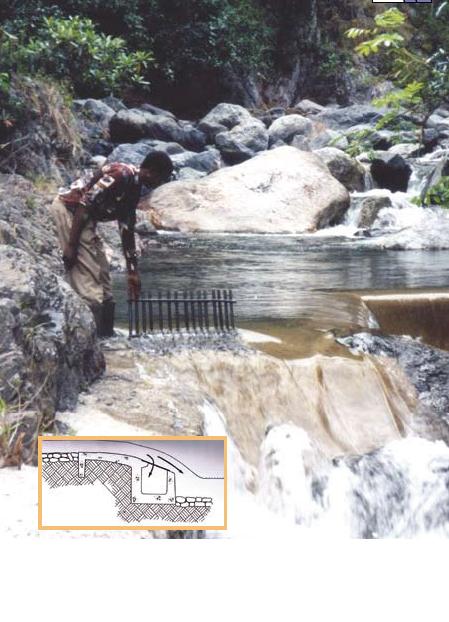Déversoir tyrolien
| |
|
|
|
|
|
|
|
|
Les barrages et structures d'entrée d'eau sur les digues sont des éléments des systèmes de distribution d'eau de rivière qui sont vulnérables et coûteux. Ils sont facilement endommagés par des inondations, des courants de fond, des infiltration et de l'accumulation de sédiments ou de déchets dans l'eau. Le déversoir tyrolien représente une alternative plus fiable et moins coûteuse.
Contents
Conditions adéquates
Les prises d'eau tyroliennes sont utilisées dans les petites rivières permanentes et les cours d'eau où la teneur en sédiments et le transport de la charge de fond sont faibles, ou au niveau du déversement en crête de barrage.
The weir or intake should be carefully sited.
Le déversoir en lui-même ne nettoie pas et ne purifie pas l'eau.
| Avantages | Inconvénients |
|---|---|
| - Plus fiables et moins coûteux comparé aux barrages et structures d'entrée d'eau au niveau des digues de la rivière.
- Ils n'affectent pas le flux d'eau des communautés en aval. |
- None known |
Resilience to changes in the environment
Drought effects on cement
Effects of drought: Badly made concrete or cracked linings (e.g. in tanks, dams, waterways, wells, and other structures).
Underlying causes of effects: Less water used for curing; Impure water used for mixing.
To increase resiliency of WASH system: Ensure adequate mixing, ratios, purity of ingredients; Minimize water content in mixture; Ensure adequate curing.
More information on managing drought: Resilient WASH systems in drought-prone areas.
Construction, operations and maintenance

The threshold can be a concrete elevation above the rocky bed of a mountain stream, or a vertical low weir structure, anchored in the embankment. The capacity of the inlet pipe / drain (diameter and gradient) should be 30% more than the design flow and have an uniform gradient to prevent accumulation of sand. The sedimentation tank can accumulate 1.5-2 m3 of deposits and allows water to filter for 10 to 30 minutes at very low speed. It is cleaned by washing it out.
Maintenance
Several visits per year to the site are necessary for inspection, cleaning and minor repairs. Overall, maintenance is easy to carry out due to low-tech structure and the use of local labour and materials.
Regular inspection and cleaning of the grit / rack and possibly the gutter and sedimentation tank is required during and after storm periods.
Costs
- Material (excluding the pipe and sedimentation tank): US$ 300 - 600.
- Labour (if site is easily accessible): 30 - 50 man days.
Manuals, videos and links
- Surface water intake and small dams. Chapter 11. Revised by Nhamo Masanganise.
Acknowledgements
- CARE Nederland, Desk Study: Resilient WASH systems in drought-prone areas. October 2010.

